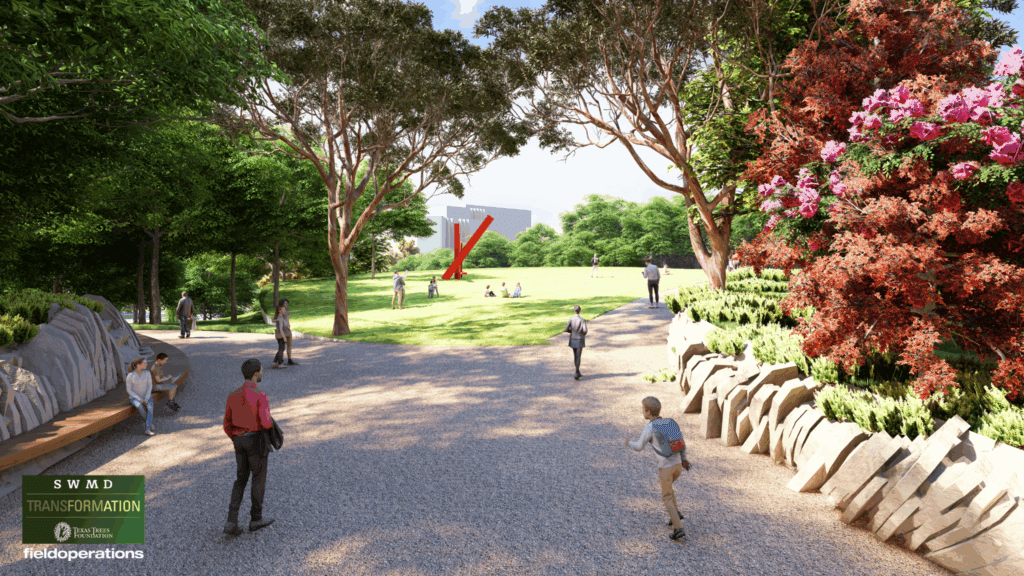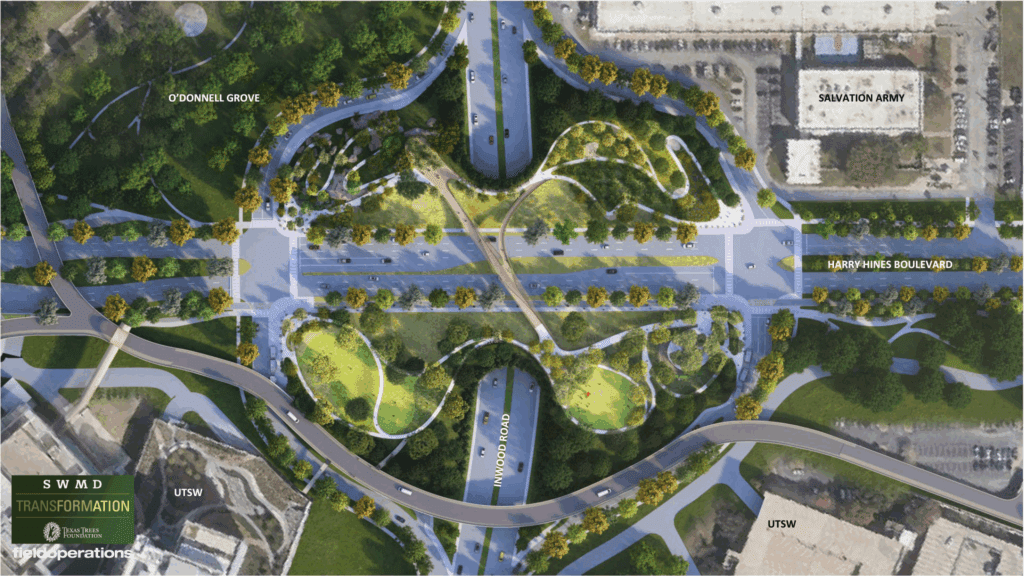by Heather Stevens
In a philanthropic landscape long dominated by buildings and naming rights, a quiet yet powerful transformation is underway. Today’s most visionary donors are no longer asking what will be built in their name. Instead, they are asking how a planned space will make people feel—how it will invite connection, foster impact, and grow in meaning over time.
This evolution—from bricks and mortar to meaning and memory—is redefining the practice of giving. At the heart of this shift lies the Southwestern Medical District (SWMD) Transformation, a bold initiative by the Texas Trees Foundation that is not only revitalizing a landscape, but reimagining legacy itself.
From Structures to Stories: The Rise of Placemaking Philanthropy
The placemaking movement emphasizes that spaces are not simply backdrops for human activity—they are co-creators of community well-being. Parks, promenades, gardens, and shaded walkways offer more than physical access—they offer emotional refuge, cultural resonance, and a vibrant quality of life.
"Unlike static buildings, outdoor spaces invite people to share, connect, and feel a sense of safety and tranquility in nature,” says Janette Monear, President and CEO of the Texas Trees Foundation. “They are spaces where a living landscape embraces people at any moment in time and in any circumstance, helping them catch their breath and re-center their thoughts beneath the trees, flowers, and open sky, whether with family, friends, or by themselves."

The SWMD Transformation Project brings this philosophy to life at scale. Spanning nearly two miles and more than 48 acres in the center of Dallas, the plan will replace sterile concrete corridors with a green, walkable, tree-rich environment that welcomes patients, and their loved ones, providers, students, and residents alike. The power of place, here, is no metaphor. It is a living intervention, a prescription for nature if you will.
Studies affirm what intuition suggests: shaded, green, accessible public spaces reduce stress, promote faster healing, enhance physical activity, and improve public safety. But for the donors fueling this transformation, the real reward is not data points—it’s the lived experience of a place that feels human.
A National Movement: Placemaking that Inspires Philanthropy
The SWMD project is part of a larger national awakening—one that places value not just on what is built, but on how space shapes emotion, health, and community connection. Consider the following projects that embody this ethos and spurred community transformation through building a place together:
The High Line - New York City, NY
Once an abandoned rail line, the High Line has become one of the most iconic public spaces in the country. Donors invested not in infrastructure but in experience—an urban promenade that stitches together ecology, art, and leisure in the heart of Manhattan.
Gathering Place - Tulsa, OK
Backed by the George Kaiser Family Foundation, this $465 million riverfront park was conceived as a civic gift to unify a diverse city. With inclusive play areas, cultural pavilions, and lush landscaping, it shows how place can promote social healing and shared joy.
11th Street Bridge Park - Washington, D.C.
This innovative project transforms a disused freeway bridge into a destination for health, culture, and community. With access and local engagement at its core, it demonstrates that placemaking can also be a platform for restorative healing and social connection.
These examples echo the SWMD mission: place as catalyst, not ornament; landscape as impact, not embellishment. The work on the High Line inspired the Texas Trees Foundation to engage the firm, Field Operations, who led its design effort and is now leading the SWMD Transformation Project. Each project has drawn donor support not by asking for walls, but by promising wonder.

Legacy in Living Systems
This is not philanthropy in the old sense. Donors supporting the SWMD Transformation are not just underwriting infrastructure—they are shaping living systems that support human health and environmental sustainability for generations to come.
From mature shade trees that will reduce urban heat and create a cooler pedestrian experience, to pollinator gardens and cultural gathering spaces, every element is designed with intention. These aren’t just amenities. They are the heartbeat of place.
When donors invest in the SWMD Transformation project, they are investing in:
- Healing environments that nurture patients, providers, students, and residents
- Green infrastructure that improves air quality, combats heat stress, and enriches biodiversity
- Civic commons where nature, science, and art meet in public view with abundant amenities that help people experience the varieties the space has to offer
- Public realm experiences that position Dallas as a national leader in urban design innovation
A Legacy That Grows in Value
Buildings are important, but have expiration dates. They become outdated, require renovation, or fall out of use. Outdoor spaces rooted in community and nature grow more meaningful over time. A tree planted today becomes tomorrow’s shade. A pathway laid now becomes the route to connectivity, legacy and restoration.
That is the promise of placemaking philanthropy—and the essence of the SWMD Transformation vision.
The SWMD project is grounded in design principles that prioritize native ecosystems, climate resilience, and accessibility. Donor support here don’t just build—they bloom.
“The data is undeniable on this forward-thinking plan: Healthy environments improve health outcomes. The SWMD Urban Streetscape and Park Project must be a priority for Dallas. The well-defined, research supported need proves we must raise the standards of the outdoor environment to match the skill, talent and technology that goes on inside the hospitals”.
- Lyda Hill, Philanthropist and Founder of Lyda Hill Philanthropies
A New Model for Giving
The question is no longer what are we building? but what are we becoming? The SWMD Transformation invites supporters and partners to shape a new identity for Dallas—one where human health and well being, public safety, and environmental resilience, are not afterthoughts, but fundamentals.
This is the new model for transformative giving: Fund a place, not just a project. Cultivate connection, not just construction. Create legacy, not just landmarks.
The Texas Trees Foundation invites you to be part of this once-in-a-generation effort. The SWMD Transformation is more than just landscape design—it is a reawakening at the intersection of human health and nature. It is an invitation to root your legacy not in walls, but in wonder. Not in marble, but in meaning. Not in isolation, but in place.

To learn how your philanthropy can build a living legacy, contact us today. Together, let’s plant the future.
